Aero Engine Roadmap 2050 - MTU Aero Engines
Aero Engine Roadmap 2050 - MTU Aero Engines
Aero Engine Roadmap 2050 - MTU Aero Engines
Create successful ePaper yourself
Turn your PDF publications into a flip-book with our unique Google optimized e-Paper software.
<strong>Aero</strong> <strong>Engine</strong> <strong>Roadmap</strong> <strong>2050</strong><br />
Dr. Jörg Sieber<br />
<strong>Aero</strong>space Industry Exhibition Tokyo 2011<br />
Tokyo, October 26 - 28, 2011
Content<br />
Future Requirements<br />
Improvement Opportunities<br />
Innovative Module Technologies<br />
New <strong>Aero</strong> <strong>Engine</strong> Concepts<br />
• Improved Propulsive Efficiency<br />
• Improved Thermal Efficiency<br />
• Long-term Concepts<br />
<strong>Engine</strong> <strong>Roadmap</strong> and Future Air Traffic<br />
Oct. 28, 2011 <strong>Aero</strong> <strong>Engine</strong> <strong>Roadmap</strong> <strong>2050</strong> - Dr. J. Sieber 2
Relative Change<br />
5<br />
4<br />
3<br />
2<br />
1<br />
0<br />
Future Requirements<br />
Air Traffic and CO 2 -Emissions<br />
Air traffic<br />
2% annual<br />
improvement<br />
Fuel consumption<br />
& CO 2 -emissions<br />
IATA goals for air transport:<br />
• Carbon neutral growth from 2020<br />
• 50% absolute reduction in CO 2 -emissions by <strong>2050</strong><br />
2000 2010 2020 2030 2040 <strong>2050</strong><br />
Business as usual<br />
Additional measures<br />
•Innovative technologies<br />
•Biofuels<br />
•Air traffic management<br />
•Economic instruments<br />
Oct. 28, 2011 <strong>Aero</strong> <strong>Engine</strong> <strong>Roadmap</strong> <strong>2050</strong> - Dr. J. Sieber 3
NO x -Emissions<br />
Future Requirements<br />
NOx limits have been reduced in several steps<br />
Further tightening of NOx limits are in discussion<br />
<strong>Engine</strong> certification according to ICAO LTO (landing take-off ) cycle<br />
ICAO limits depend on overall pressure ratio in order to take into account combustor<br />
behavior and engine efficiency<br />
NO x rel. to CAEP/6 %<br />
80<br />
60<br />
40<br />
20<br />
0<br />
-20<br />
-40<br />
-60<br />
-80<br />
Progress in NO x certification limits<br />
CAEP/1**<br />
CAEP/2**<br />
CAEP/4**<br />
CAEP/6<br />
ICAO Goals*<br />
Medium Term<br />
Long Term<br />
1990 2000 2010 2020 2030<br />
* www.icao.int/icao/en/Env2010/TechnologyStandards.htm ** OPR=30<br />
ICAO NOx [g/kN]<br />
0<br />
10 20 30 40 50<br />
Overall Pressure Ratio<br />
Oct. 28, 2011 <strong>Aero</strong> <strong>Engine</strong> <strong>Roadmap</strong> <strong>2050</strong> - Dr. J. Sieber 4<br />
140<br />
120<br />
100<br />
80<br />
60<br />
40<br />
20<br />
ICAO NO x limits and engine test data<br />
CAEP/1<br />
CAEP/2<br />
CAEP/4<br />
CAEP/6<br />
ICAO Medium Term Goal*<br />
ICAO Long Term Goal*
Noise Emissions<br />
Tight regulations by ICAO and locally<br />
Further tightening of noise limits are in discussion<br />
Expected growth in world air traffic causes significant environmental challenges<br />
Noise is becoming an important economic factor because of noise charges, quotas and<br />
flight bans<br />
EPNdB rel. to Stage 3<br />
30<br />
20<br />
10<br />
0<br />
-10<br />
-20<br />
-30<br />
-40<br />
Future Requirements<br />
Progress in noise certification limits<br />
Stage 2<br />
Stage 3<br />
ICAO Goals*<br />
Stage 4<br />
Medium Term<br />
Long Term<br />
1970 1990 2010 2030<br />
* www.icao.int/icao/en/Env2010/TechnologyStandards.htm, small-med. range twin<br />
Growth in airport noise restrictions**<br />
Oct. 28, 2011 <strong>Aero</strong> <strong>Engine</strong> <strong>Roadmap</strong> <strong>2050</strong> - Dr. J. Sieber 5<br />
Number of Airports<br />
600<br />
400<br />
200<br />
0<br />
Restrictions:<br />
• Curfews<br />
• Noise charges<br />
• Noise level limits<br />
• Operating quotas<br />
1970 1980 1990 2000 2010<br />
** www.boeing.com/commercial/noise/restrictions.pdf
Future Requirements<br />
Environmental Objectives for Future Aviation<br />
CO2 /<br />
Fuel<br />
NO x<br />
Noise<br />
ACARE 2020 1<br />
50% reduction in CO 2<br />
per passenger<br />
kilometer<br />
by 2020 rel. to 2000<br />
80% reduction in NO x<br />
per passenger<br />
kilometer<br />
by 2020 rel. to 2000<br />
50% reduction of<br />
aircraft perceived noise<br />
by 2020 rel. to 2000<br />
NASA Goals 2<br />
50% reduction in CO 2<br />
of new aircraft in 25<br />
years<br />
80% reduction in NO x<br />
of new aircraft in 25<br />
years<br />
75% reduction of<br />
perceived noise of new<br />
aircraft in 25 years<br />
Flightpath <strong>2050</strong> 3<br />
75% reduction in CO 2<br />
per passenger<br />
kilometer<br />
by <strong>2050</strong> rel. to 2000<br />
90% reduction in NO x<br />
per passenger<br />
kilometer<br />
by <strong>2050</strong> rel. to 2000<br />
65% reduction of<br />
aircraft perceived noise<br />
by <strong>2050</strong> rel. to 2000<br />
IATA 4<br />
1.5% annual fuel<br />
efficiency improvement<br />
from 2009 to 2020<br />
carbon neutral growth<br />
of air traffic from 2020<br />
50% reduction of air<br />
traffic CO 2 emissions<br />
2 emissions<br />
by <strong>2050</strong> rel. to 2005<br />
1 European <strong>Aero</strong>nautics: A Vision for 2020, Report of the group of personalities, European Commission 2001, ACARE (Advisory Council for <strong>Aero</strong>nautics Research in Europe)<br />
2 Goals and Objectives for the <strong>Aero</strong>space Technology Enterprise,1997, National <strong>Aero</strong>nautics and Space Administration (NASA)<br />
3 Flightpath <strong>2050</strong> Europe‘s Vision for Aviation, Report of the high level group on aviation research, European Commission 2011<br />
4 IATA Press Releases Kuala Lumpur June 2009; www.iata.org/pressroom/pr/pages/2009-06-08-03.aspx<br />
5 37th Session of the ICAO Assembly Oct. 2010; www.icaoint/icao/en/Env2010/Pubs/ICAO_ENVBrochure_en.pdf &<br />
6 www.icaoint/icao/en/Env2010/Technologystandards.htm<br />
ICAO 5/6<br />
2% annual fuel<br />
efficiency improvement<br />
up to <strong>2050</strong><br />
carbon neutral growth<br />
of air traffic from 2020<br />
development of a CO2 standard for aircraft for<br />
2013<br />
-45% rel. to CAEP6<br />
LTO cycle by 2016<br />
(OPR 30)<br />
-60% rel. to CAEP6<br />
LTO cycle by 2026<br />
(OPR 30)<br />
-21 EPNdB rel. to<br />
Chapter 4 by 2018<br />
(small-med. range twin)<br />
-23.5 EPNdB rel. to<br />
Chapter 4 by 2028<br />
(small-med. range twin)<br />
Oct. 28, 2011 <strong>Aero</strong> <strong>Engine</strong> <strong>Roadmap</strong> <strong>2050</strong> - Dr. J. Sieber 6
Efficiency of <strong>Aero</strong> <strong>Engine</strong>s<br />
Improvement Opportunities<br />
Propulsion Efficiency %<br />
100<br />
90<br />
80<br />
70<br />
60<br />
50<br />
ideal<br />
installed<br />
5 10 15 20 25 30<br />
Bypass Ratio<br />
engine cycle<br />
bypass ratio pressure ratio<br />
η total = η propulsion installation · η thermal temperature<br />
…. module efficiency<br />
…<br />
Oct. 28, 2011 <strong>Aero</strong> <strong>Engine</strong> <strong>Roadmap</strong> <strong>2050</strong> - Dr. J. Sieber 7<br />
Thermal Efficiency %<br />
60<br />
50<br />
40<br />
30<br />
20<br />
10<br />
0<br />
T max = 2000 K<br />
1000 K<br />
1500 K<br />
0 10 20 30 40 50<br />
Overall Pressure Ratio
Ideal and Real <strong>Aero</strong> <strong>Engine</strong><br />
Thermal Efficiency<br />
1,0<br />
0,9<br />
0,8<br />
0,7<br />
0,6<br />
0,5<br />
0,4<br />
30<br />
20<br />
Improvement Opportunities<br />
15<br />
0,3<br />
0,3 0,4 0,5 0,6 0,7 0,8 0,9 1<br />
10<br />
Turbofan<br />
1960 2010<br />
Propulsive Efficiency<br />
SFC<br />
g/kN/s<br />
7,5<br />
Open Rotor<br />
Ideal engine cycles<br />
Carnot T max = 2000K<br />
Joule OPR = 80<br />
Oct. 28, 2011 <strong>Aero</strong> <strong>Engine</strong> <strong>Roadmap</strong> <strong>2050</strong> - Dr. J. Sieber 8
Bypass Ratio<br />
Development of Bypass Ratio and Overall Pressure Ratio<br />
12<br />
10<br />
8<br />
6<br />
4<br />
2<br />
0<br />
Improvement Opportunities<br />
1960 1970 1980 1990 2000 2010<br />
Certification<br />
Overall Pressure Ratio<br />
Oct. 28, 2011 <strong>Aero</strong> <strong>Engine</strong> <strong>Roadmap</strong> <strong>2050</strong> - Dr. J. Sieber 9<br />
60<br />
50<br />
40<br />
30<br />
20<br />
10<br />
1960 1970 1980 1990 2000 2010<br />
Certification<br />
Bypass ratio and overall pressure ratio has been increased in the past in order to<br />
improve fuel efficiency and reduce noise emission.
Surge control<br />
by tip injection<br />
Non axisymmetric<br />
endwalls<br />
Aspirated<br />
blading<br />
Innovative Module Technologies<br />
Innovative Compressor Technologies - Examples<br />
Advanced<br />
casing<br />
treatment<br />
Rub<br />
management<br />
Blade tip<br />
Abradable<br />
Casing<br />
aspiration<br />
Active clearance<br />
control<br />
All BLISK rotor<br />
Oct. 28, 2011 <strong>Aero</strong> <strong>Engine</strong> <strong>Roadmap</strong> <strong>2050</strong> - Dr. J. Sieber 10
Ceramic matrix<br />
composite (CMC)<br />
Integral 3D<br />
design<br />
Efficient cooling<br />
systems<br />
Innovative Module Technologies<br />
Innovative Turbine Technologies - Examples<br />
Micro-structured<br />
blade surfaces<br />
High stage<br />
loading<br />
Low noise<br />
design<br />
Low weight<br />
materials (TiAl)<br />
Turbine Blisk<br />
Oct. 28, 2011 <strong>Aero</strong> <strong>Engine</strong> <strong>Roadmap</strong> <strong>2050</strong> - Dr. J. Sieber 11
Main combustion zone:<br />
lean burning<br />
(out at lower powers)<br />
Pilot: rich burning zone<br />
(stable to low power)<br />
Innovative Module Technologies<br />
Innovative Combustor Technologies - Lean Combustion<br />
Lean combustion operates with an<br />
excess of air to significantly lower flame<br />
temperatures and consequently reduce<br />
NOx formation.<br />
To overcome the narrow operating<br />
range of lean combustion, fuel staging<br />
is required.<br />
DPNOx/Foo g/kN<br />
0<br />
10 20 30 40 50 60 70 80<br />
Oct. 28, 2011 <strong>Aero</strong> <strong>Engine</strong> <strong>Roadmap</strong> <strong>2050</strong> - Dr. J. Sieber 12<br />
100<br />
80<br />
60<br />
40<br />
20<br />
LP(P)<br />
Combustor<br />
LPP<br />
NO x CAEP2<br />
PERM<br />
LDI<br />
Overall Pressure Ratio<br />
PERM<br />
Combustor<br />
LDI<br />
Combustor<br />
LPP<br />
40% CAEP2<br />
PERM<br />
35% CAEP2<br />
LDI<br />
30% CAEP2
Geared Turbofan<br />
Description<br />
• Gear between low pressure turbine and fan<br />
• High speed low pressure turbine<br />
• High bypass ratio > 12<br />
Benefits<br />
• High propulsive efficiency<br />
• Efficient and light weight low pressure turbine<br />
• 15% reduced fuel consumption *<br />
• 24 dB noise reduction (accumulated) *<br />
• EIS 2013<br />
Challenges<br />
• Low drag nacelle<br />
• Gearbox<br />
• Light weight design<br />
* rel. to year 2000 engine<br />
New <strong>Aero</strong> <strong>Engine</strong> Concepts<br />
Improved Propulsive Efficiency<br />
Oct. 28, 2011 <strong>Aero</strong> <strong>Engine</strong> <strong>Roadmap</strong> <strong>2050</strong> - Dr. J. Sieber 13
Noise Simulation: Pratt & Whitney<br />
SEL Contour Source: Wyle Laboratories<br />
New <strong>Aero</strong> <strong>Engine</strong> Concepts<br />
Improved Propulsive Efficiency<br />
Geared Turbofan – Noise Reduction<br />
Munich Airport<br />
Current aircraft Next Generation aircraft with<br />
Geared Turbofan<br />
Reduction of 75dB noise contour by 72%<br />
Oct. 28, 2011 <strong>Aero</strong> <strong>Engine</strong> <strong>Roadmap</strong> <strong>2050</strong> - Dr. J. Sieber 14
Studies Component Development Demonstrators Flight Tests Applications<br />
Rotor aerodynamics<br />
Studies<br />
New <strong>Aero</strong> <strong>Engine</strong> Concepts<br />
Improved Propulsive Efficiency<br />
Geared Turbofan – Technology Development<br />
Demonstrator 50 klb<br />
windtunnel tests<br />
Flight gearbox 32k SHP<br />
Demonstrator 28 klb<br />
engine tests<br />
Demonstrator 13 klb<br />
engine tests<br />
First flight<br />
FTB Boeing B747<br />
Mitsubishi MRJ<br />
Bombardier CSeries<br />
Irkut MC-21<br />
Airbus A320 NEO<br />
1980 1990 2000 2010 2020<br />
Oct. 28, 2011 <strong>Aero</strong> <strong>Engine</strong> <strong>Roadmap</strong> <strong>2050</strong> - Dr. J. Sieber 15
Open Rotor<br />
Description<br />
• Open counter-rotating fan<br />
• Gearbox or counter-rotating low pressure turbine<br />
• „pusher“ or „puller“ configuration<br />
• Very high bypass ratio<br />
Benefits<br />
• Very high propulsive efficiency<br />
• 20% reduced fuel consumption *<br />
• Technology readiness 2020+<br />
Challenges<br />
• Noise emission (far field + cabin)<br />
• Installation<br />
• High flight velocity<br />
• Blade pitch change mechanism<br />
• Certification (blade off / bird strike)<br />
• Gearbox / counter-rotating turbine<br />
* rel. to year 2000 engine<br />
New <strong>Aero</strong> <strong>Engine</strong> Concepts<br />
Improved Propulsive Efficiency<br />
pusher<br />
puller<br />
Oct. 28, 2011 <strong>Aero</strong> <strong>Engine</strong> <strong>Roadmap</strong> <strong>2050</strong> - Dr. J. Sieber 16
Open Rotor<br />
New <strong>Aero</strong> <strong>Engine</strong> Concepts<br />
Improved Propulsive Efficiency<br />
Development of the new engine concept after the OPEC oil embargo in the USA by<br />
General Electric und Pratt&Whitney-Allison.<br />
• GE36 from GE, driven by a counter-rotating low pressure turbine<br />
• 578-DX from P&W-Allison, driven by a gearbox<br />
Demonstrator flights using B727 and MD80 in the late 1980s<br />
The development was stopped because of falling fuel prices and unsolved noise<br />
problems (noise emission approximately ICAO Stage 3).<br />
Restart of the Open Rotor development by Rolls Royce and GE.<br />
P&W-Allison 578-DX General Electric GE36<br />
Tail mounted<br />
Oct. 28, 2011 <strong>Aero</strong> <strong>Engine</strong> <strong>Roadmap</strong> <strong>2050</strong> - Dr. J. Sieber 17
Thermal Efficiency<br />
New <strong>Aero</strong> <strong>Engine</strong> Concepts<br />
Improved Thermal Efficiency<br />
Thermal Efficiency for Different <strong>Engine</strong> Cycles<br />
Intercooled<br />
IC HEX<br />
Recuperated LPC HPC<br />
Com.<br />
HPT<br />
5 10 20 50<br />
100<br />
Overall Pressure Ratio<br />
Intercooled<br />
Conventional<br />
Oct. 28, 2011 <strong>Aero</strong> <strong>Engine</strong> <strong>Roadmap</strong> <strong>2050</strong> - Dr. J. Sieber 18<br />
LPT<br />
Intercooled Recuperated<br />
IC<br />
Com.<br />
LPC HPC HPT<br />
Intercooled<br />
Com.<br />
LPC HPC HPT<br />
Conventional<br />
LPT<br />
LPT
Intercooled Core<br />
Description<br />
• Intercooler between low pressure and<br />
high pressure compressor<br />
• Conventional or geared fan<br />
• High overall pressure ratio > 70<br />
Benefits<br />
• High thermal efficiency<br />
• 20% reduced fuel consumption *<br />
• Technology readiness > 2025<br />
Challenges<br />
• Integration of intercooler<br />
• Low pressure loss ducting and<br />
intercooler<br />
• Light weight and efficient intercooler<br />
• Efficient compressor for high pressures<br />
* rel. to year 2000 engine<br />
New <strong>Aero</strong> <strong>Engine</strong> Concepts<br />
Improved Thermal Efficiency<br />
Oct. 28, 2011 <strong>Aero</strong> <strong>Engine</strong> <strong>Roadmap</strong> <strong>2050</strong> - Dr. J. Sieber 19
Intercooled<br />
engine<br />
intercase<br />
Intercooler<br />
ducting system<br />
New <strong>Aero</strong> <strong>Engine</strong> Concepts<br />
Improved Thermal Efficiency<br />
Intercooled Core – Technologies<br />
Intercooler<br />
modules<br />
Stability<br />
enhancement<br />
(tip blowing)<br />
Tip clearance<br />
control<br />
LDI combustor<br />
20<br />
Oct. 28, 2011 <strong>Aero</strong> <strong>Engine</strong> <strong>Roadmap</strong> <strong>2050</strong> - Dr. J. Sieber 20
Intercooled Recuperated Core<br />
Description<br />
• Intercooler between low pressure and<br />
high pressure compressor<br />
• Exhaust gas heat exchanger<br />
• Geared fan<br />
• Low overall pressure ratio ~ 25<br />
Benefits<br />
• Very high thermal efficiency<br />
• Low NO X -Emissions<br />
• 30% reduced fuel consumption *<br />
• Technology readiness > 2035<br />
Challenges<br />
• Integration of intercooler and heat<br />
exchanger<br />
• Low pressures loss ducting, intercooler<br />
and heat exchanger<br />
• Low weight and efficient heat exchanger<br />
* rel. to year 2000 engine<br />
New <strong>Aero</strong> <strong>Engine</strong> Concepts<br />
Improved Thermal Efficiency<br />
Oct. 28, 2011 <strong>Aero</strong> <strong>Engine</strong> <strong>Roadmap</strong> <strong>2050</strong> - Dr. J. Sieber 21
Intercooled Recuperated Core – Technologies<br />
Axial / radial<br />
compressor<br />
New <strong>Aero</strong> <strong>Engine</strong> Concepts<br />
Improved Thermal Efficiency<br />
Heat exchanger<br />
Heat exchanger<br />
arrangement and<br />
ducting system<br />
Lean Premixed<br />
Pre-vapourised<br />
combustor<br />
Oct. 28, 2011 <strong>Aero</strong> <strong>Engine</strong> <strong>Roadmap</strong> <strong>2050</strong> - Dr. J. Sieber 22
All Electric Flight<br />
Description<br />
• Electric driven propeller,<br />
open rotor or ducted fan<br />
• Energy storage by batteries<br />
Benefits<br />
• Zero emission (during flight)<br />
• Independence from oil resources<br />
Challenges<br />
• Specific energy of batteries<br />
(kWh/kg)<br />
• Power to weight ratio of electric<br />
motors (high temperature<br />
superconductivity necessary)<br />
New <strong>Aero</strong> <strong>Engine</strong> Concepts<br />
Long-term Concepts<br />
Range (nm)<br />
Example: Electrification of an<br />
ATR72-600<br />
Assumptions<br />
• Battery capacity: 200 Wh/kg<br />
2010, 5% p.a. improvement<br />
• Fuel replaced by batteries (5 t)<br />
• Electric motors using high<br />
temperature superconductivity<br />
(HTS)<br />
Oct. 28, 2011 <strong>Aero</strong> <strong>Engine</strong> <strong>Roadmap</strong> <strong>2050</strong> - Dr. J. Sieber 23<br />
600<br />
500<br />
400<br />
300<br />
200<br />
100<br />
0<br />
Typical mission<br />
< 300 nm<br />
2010 2020 2030 2040 <strong>2050</strong>
Hybrid <strong>Engine</strong><br />
Description<br />
• Electric driven distributed fans<br />
• Electric generator driven by a high efficient gas<br />
turbine using an advanced thermodynamic cycle<br />
• Buffering of peak power by batteries<br />
Benefits<br />
• Reduced aircraft drag if wing/fuselage wake is<br />
reduced by distributed fans<br />
• High propulsive efficiency<br />
• Optimization of gas turbine for cruise conditions<br />
• Additional degree of freedom to integrate<br />
complex gas turbine cycles<br />
• High energy content of conventional fuel<br />
Challenges<br />
• High weight<br />
• Complex system<br />
• Transmission losses<br />
New <strong>Aero</strong> <strong>Engine</strong> Concepts<br />
Long-term Concepts<br />
E-Motor<br />
E-Motor<br />
LPC HPC HPT<br />
Gas turbine with advanced engine cycle<br />
Batterie<br />
Oct. 28, 2011 <strong>Aero</strong> <strong>Engine</strong> <strong>Roadmap</strong> <strong>2050</strong> - Dr. J. Sieber 24<br />
IC<br />
HEX<br />
COM.<br />
LPT Generator
<strong>Aero</strong> <strong>Engine</strong> <strong>Roadmap</strong> <strong>2050</strong><br />
German <strong>Aero</strong>space Industries Association (BDLI)<br />
Geared<br />
Turbofan<br />
Open<br />
Rotor<br />
<strong>Engine</strong> <strong>Roadmap</strong> & Future Air Traffic<br />
Counter<br />
Rotating<br />
Shrouded<br />
Propfan<br />
Intercooled<br />
Core<br />
Intercooled<br />
Recuperated<br />
Core<br />
All-electric<br />
Hybrid<br />
<strong>Engine</strong><br />
2010 2020 2030 2040 <strong>2050</strong><br />
Oct. 28, 2011 <strong>Aero</strong> <strong>Engine</strong> <strong>Roadmap</strong> <strong>2050</strong> - Dr. J. Sieber 25
Future Development of Air Traffic and CO 2 -Emissions<br />
Relative Change<br />
5<br />
4<br />
3<br />
2<br />
Air traffic<br />
(+5% p.a.)<br />
<strong>Engine</strong> <strong>Roadmap</strong> & Future Air Traffic<br />
CO 2 emissions<br />
business<br />
as usual<br />
(efficiency<br />
+2% p.a.)<br />
CO 2 emissions<br />
innovative<br />
technologies<br />
1<br />
0<br />
IATA objectives:<br />
• carbon neutral growth from 2020<br />
• 50% absolute reduction in CO2 emissions by <strong>2050</strong> rel. to 2005<br />
2000 2010 2020 2030 2040 <strong>2050</strong><br />
New Aircraft<br />
Concepts<br />
30% efficiency<br />
improvement *<br />
New<br />
<strong>Engine</strong>s<br />
50% efficiency<br />
improvement *<br />
Advanced<br />
Air Traffic<br />
Management<br />
20% efficiency<br />
improvement *<br />
Alternative<br />
Fuels<br />
80% carbon<br />
free fuel *<br />
* by <strong>2050</strong> rel. to 2000<br />
Oct. 28, 2011 <strong>Aero</strong> <strong>Engine</strong> <strong>Roadmap</strong> <strong>2050</strong> - Dr. J. Sieber 26


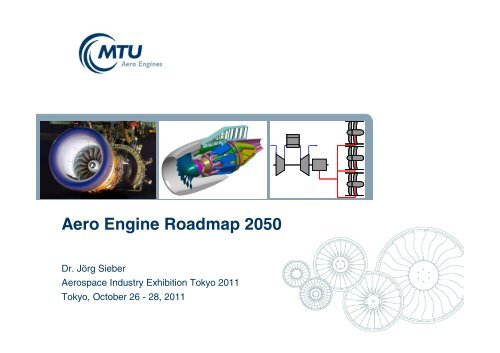
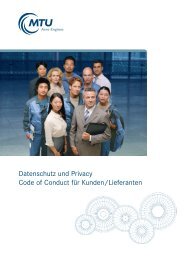

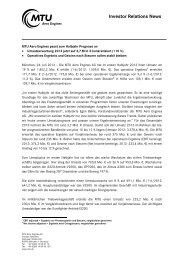
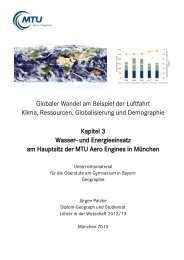
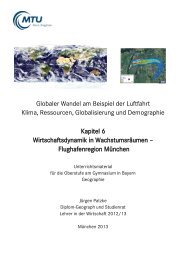
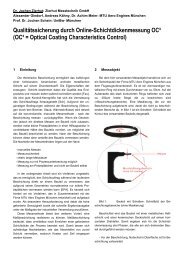
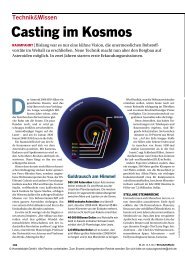

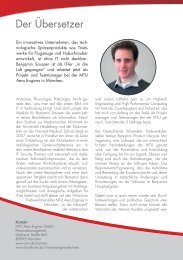
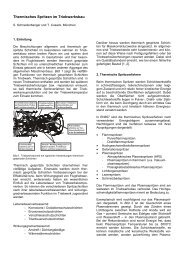
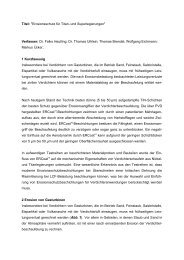


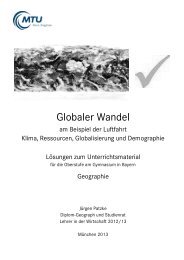
![Download PDF [5,37 MB] - MTU Aero Engines](https://img.yumpu.com/21945461/1/190x125/download-pdf-537-mb-mtu-aero-engines.jpg?quality=85)